TI LMP91000低功耗化学传感器模拟前端解决方案
发布时间:2012-1-13 00:38
发布者:1770309616
|
TI公司的LMP91000是可编程低功耗化学传感器模拟前端(AFE),提供传感器和MCU间完整的信号通路解决方案.气体灵敏度从0.5 nA/ppm到9500 nA/ppm,很容易转换成电流从5μA 到750μA.工作电压2.7V-5.25V工作电流小于10 μA,电池调理电流高达10mA,可编程电池偏压电压, 偏压电压漂移低.主要用在化学样品识别,电流计和电化学血糖仪.本文介绍了LMP91000主要特性,方框图,多种应用框图以及化学和气体传感器解决方案框图和蔼主要特性. LMP91000 Sensor AFE System: Configurable AFE Potentiostat for Low-Power Chemical Sensing Applications The LMP91000 is a programmable Analog Front End (AFE) for use in micro-power electrochemical sensing applications. It provides a complete signal path solution between a sensor and a microcontroller that generates an output voltage proportional to the cell current. The LMP91000’s programmability enables it to support multiple electrochemical sensors such as 3-lead toxic gas sensors and 2-lead galvanic cell sensors with a single design as opposed to the multiple discrete solutions. The LMP91000 supports gas sensitivities over a range of 0.5 nA/ppm to 9500 nA/ppm. It also allows for an easy conversion of current ranges from 5μA to 750μA full scale. The LMP91000’s adjustable cell bias and transimpedance amplifier (TIA) gain are programmable through the the I2C interface. The I2C interface can also be used for sensor diagnostics. An integrated temperature sensor can be read by the user through the VOUT pin and used to provide additional signal correction in the μC or monitored to verify temperature conditions at the sensor. The LMP91000 is optimized for micro-power applications and operates over a voltage range of 2.7V to 5.25V. The total current consumption can be less than 10μA. Further power savings are possible by switching off the TIA amplifier and shorting the reference electrode to the working electrode with an internal switch. LMP91000主要特性: Typical Values, TA = 25℃ ■ Supply voltage 2.7 V to 5.25 V ■ Supply current (average over time) <10 μA ■ Cell conditioning current up to 10 mA ■ Reference electrode bias current (85℃) 900pA (max) ■ Output drive current 750μA ■ Complete potentiostat circuit to interface to most chemical cells ■ Programmable cell bias voltage ■ Low bias voltage drift ■ Programmable TIA gain 2.75kΩ to 350kΩ ■ Sink and source capability ■ I2C compatible digital interface ■ Ambient operating temperature -40℃ to 85℃ ■ Package 14 pin LLP ■ Supported by Webench Sensor AFE Designer LMP91000应用: ■ Chemical species identification ■ Amperometric application ■ Electrochemical blood glucose meter 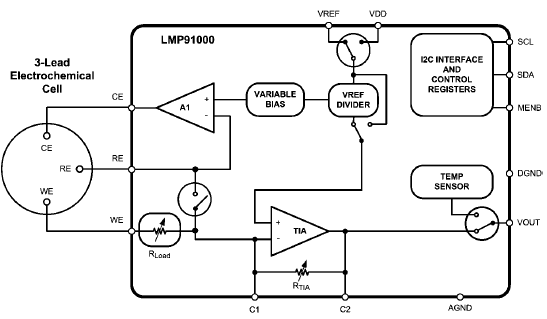
图1. LMP91000方框图 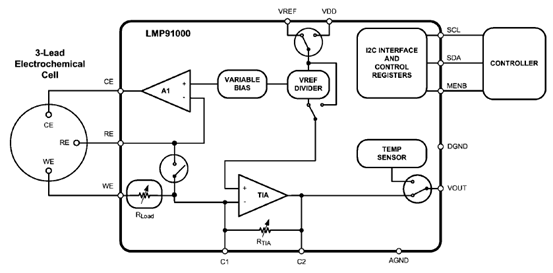
图2. LMP91000 AFE气体检测器框图 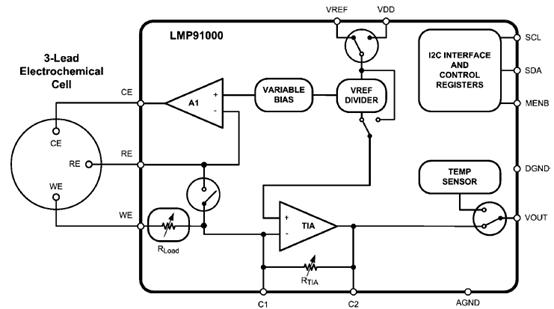
图3. LMP91000 3线电流计单元框图 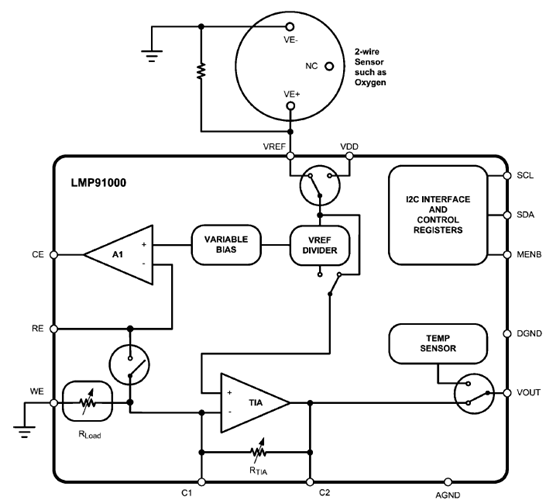
图4. LMP91000 2线原电池接地框图 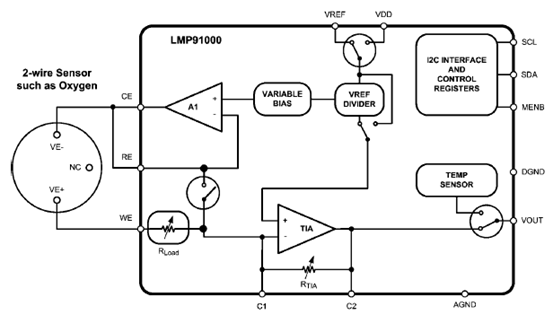
图5. LMP91000 2线原电池在恒电势器配置图 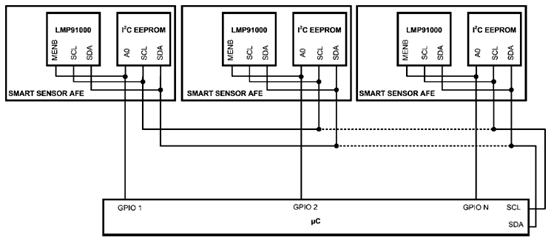
图6. LMP91000在I2C总线的智能气体传感器模拟前端(AFE)连接图 Electrochemical sensors are widely used as a sense mechanism for gas and chemical sensing. Common applications include carbon monoxide detectors, chemical species identification, Amperometric sensors etc. Electrochemical sensors can be considered simply as transducers that convert the physical characteristic of gas/chemical concentration to an electrical signal which can be processed by instrumentation. Signal Conditioning: The programmable Analog Front End (AFE) is perfect for use in micro-power electrochemical sensing applications. It provides a complete signal path solution between a sensor and a microcontroller that generates an output voltage proportional to the cell current. The programmability enables it to support multiple electrochemical sensors such as 3-lead toxic gas sensors and 2-lead galvanic cell sensors with a single design as opposed to the multiple discrete solutions. The AFE supports gas sensitivities over a range of 0.5 nA/ppm to 9500 nA/ppm. It also allows for an easy conversion of current ranges from 5µA to 750µA full scale. The adjustable cell bias and Transimpedance amplifier (TIA) gain are programmable through the I2C interface. The I2C interface can also be used for sensor diagnostics. An integrated temperature sensor can be read by the user through the VOUT pin and used to provide additional signal correction in the µC or monitored to verify temperature conditions at the sensor. The AFE is optimized for micro-power applications and operates over a voltage range of 2.7V to 5.25V. The total current consumption can be less than 10μA. Further power savings are possible by switching off the TIA amplifier and shorting the reference electrode to the working electrode with an internal switch. Signal Acquisition and Processing: TI’s high resolution differential ADCs have low power consumption, wide dynamic range and low noise. This can be used to digitize the conditioned analog bridge output for high resolution, precision measurements. Alternately, one could use TI’s MSP430 microcontrollers with integrated ADCs and DACs. Further post processing algorithms can be run on this MCU. Interface and Communication: Traditional analog (4 - 20mA) interface remains the popular choice for industrial control and sensor applications. The other popular protocols include HART, Profibus and IO-Link. TI’s IO-Link interface products have integrated regulators and diagnostic outputs. In addition, wireless options based on IEEE 802.15.4 protocols are becoming more prevalent. TI is committed to provide solutions for both traditional and emerging industrial interfaces. Power Management The Field Transmitter can be powered in one of three ways. Line powered transmitters are commonly powered by voltage rails of 12V, or 24V. Loop powered transmitters are powered by the 4-20 mA loop. Such transmitters require extremely low power architectures as the entire solutions has to be powered off the loop. TI provides high efficiency Step Down converters with low quiescent current and low output ripple appropriate for Line and Loop powered transmitters. Battery powered transmitters powered can be designed using TI’s low power Buck and Buck-Boost converters. The DC/DC buck converters offer over 95% efficiency over a wide battery voltage range, even with input voltage down to 1.8 volts extending battery life. Special Buck-Boost converters generate a stable required output voltage and supply constant current for over- and under-input voltage conditions and support various battery configurations. 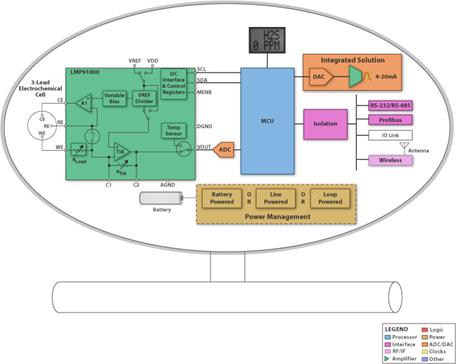
图7. LMP91000化学和气体传感器解决方案框图 解决方案主要特性: Configurable AFE with integrated electrode excitation One design solution fits multiple electro-chemical sensors 16-bit MCU for configuration and communication Extremely low power extends battery life and ensures operation under 4mA Enables online or factory programmed configuration and calibration of sensor 4-20mA Current Loop Transmitter Integrated 5V regulator capable of providing system power .05% span error 详情请见:  lmp91000[1].pdf
(599.94 KB)
lmp91000[1].pdf
(599.94 KB)
|







网友评论